Lithuanian varieties
Identity
Language typology:Indo-European family
» Balto-Slavic
» Baltic
» Eastern
» Lithuanian
The most closely related language to the Lithuanian language is Latvian, which is also a member of Eastern Baltic languages (Vaičiulytė-Romančuk 2006: 7
 Vaičiulytė-Romančuk 2006 / komentarz/comment/r /
Vaičiulytė-Romančuk 2006 / komentarz/comment/r / Vaičiulytė-Romančuk, Ona 2006. Gramatyka języka litewskiego. Warszawa: Ex Libris.
 ). Other Slavic languages are also related to Lithuanian.
). Other Slavic languages are also related to Lithuanian.In the ISO 639-3 standard, Lithuanian’s code is lit.
The Aukshtaitish dialect is much closer to the Lithuanian literary language (the literary language was created on a basis of Western Aukshtaitish dialectdialect from around Kovno) than Zhemaitish dialect, which resembles the Latvian language. Aukshtaitish is also used on an area almost three times bigger (the Central, Eastern and Southern areas of the country) than the Zhemaitish dialect (spoken in the Western part of the country).
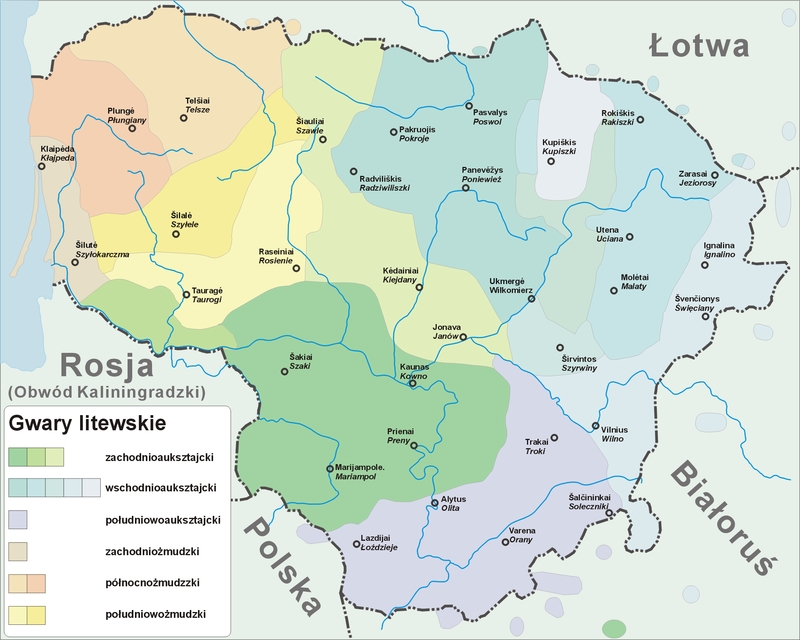
Lithuanian dialects. [map ed.: Jacek Cieślewicz, #JS#based on http://www.tarmes.lt/images/tarmiu_skirstymas/zem_1_nauja%20klasifikacija.gif ]
As it was mentioned before, Lithuanians living in Poland use two dialects: Western Aukshtaitish and Southern Aukshtaitish.

(Hasiuk 1978: 5
 Hasiuk 1978 / komentarz/comment/r /
Hasiuk 1978 / komentarz/comment/r / Hasiuk, Michał 1978. Fonologia litewskiej gwary sejneńskiej. Poznań: Wydawnictwo Naukowe Uniwersytetu im. Adama Mickiewicza
 )
)Those who speak the Southern Aukshtaitish dialect are called Dzuks due totheir “dzuking”. Nowadays the name “Dzuks” (dzūkai) has an ethnographinc meaning, although it comes from a nickname given to them by the Kaps and other Lithuanians (Niewulis 2005: 17
 Niewulis 2005 / komentarz/comment/r /
Niewulis 2005 / komentarz/comment/r / Niewulis [-Grablunas], Jowita 2005. Fonologia litewskiej gwary puńskiej. Poznań: [Niepublikowana praca doktorska].
 ). Dzuks’ name, in turn, was used to forge a name of another Lithuanian region – Dzukija (Dzūkija).
). Dzuks’ name, in turn, was used to forge a name of another Lithuanian region – Dzukija (Dzūkija). DZUKING (dzūkavimas) – it is a very noticeable phenomenon in the Southern Aukshtaitish dialect, consisting of two particular consonant characteristics:
- derived from tj, dj, consonants č, dž, present in the literary Lithuanian language are pronounced as c’/c, dz’/dz in South-Aukshtaitish, examples: lit. Lith. svečiai, Southern Aukshtaitish sveciai/svecai ‘guests’, lit. Lith džiaugsmas, Southern Aukshtaitish dziaugsmas/dzaugsmas ‘joy’,
- t, d (and linkings tv, dv) transform into c, dz (cv, dzv) before i, į, y, ie, for example, lit. Lith. tiek, Southern Aukshtaitish ciek ‘as many’, lit. Lith. diena, Southern Aukshtaitish dziena ‘dzień’, lit. Lith. tylus, Southern Aukshtaitish culys ‘silent’, lit. Lith. dvylika, Southern Aukshtaitish dzvylika ‘twelve’ (Zinkevičius 1978: 42
 Zinkevičius 1978 / komentarz/comment/r /
Zinkevičius 1978 / komentarz/comment/r /
Zinkevičius, Zigmas 1978. Lietuvių kalbos dialektologija. Wilno: Mokslas. ).
).
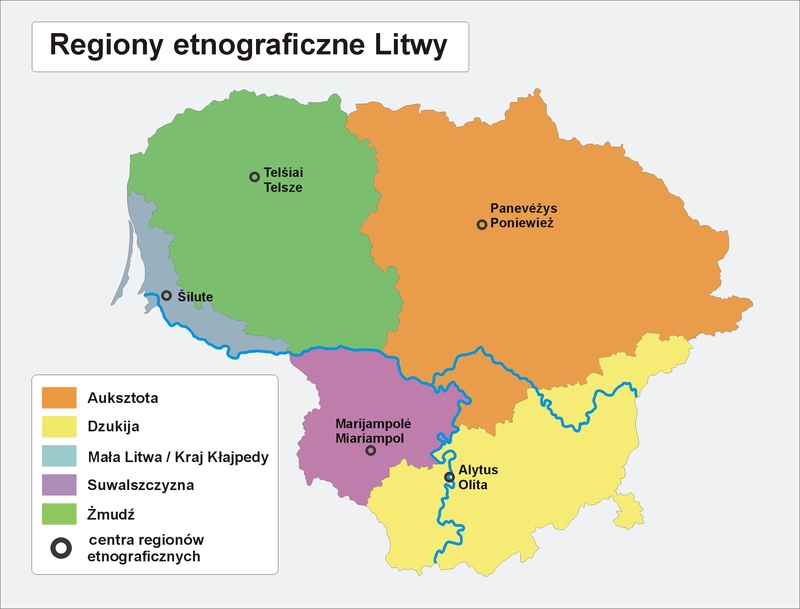
Ethnographic regions of Lithuania [map ed.: Jacek Cieślewicz]
Another name of Dzukija is Dainava. It was first mentioned in 1253 in King Mindaugas’ letter to the Livonian Brothers of the Sword. Most probably, it was a duchy at the time.
Dzukija was never treated as a separate administrative unit, though the idea of separateness was promoted by the president Rolandas Paksas. Dzukija has its own coat-of-arms depicting a knight on the blue background, supported by two lynx, with an inscription (motto) in Latin : Ex gente bellicosissima populus laboriosus – “Out of the most gallant tribe – a resourceful people”, and its capital is Alytus.
Dzuks, more than other Lithuanians, tend to palatalize t, d which did not turn into c, dz. The reason for that change is not clear. It may be due to the influence of Belarussian, though Lithuanian dialect from the region of nowadays Belarus (the area of Lith. Zietela, Bel. Дзятлава, Dziatława, Eng. Dzyetlava), which is most influenced, does not do dzuking at all (Zinkevičius 1978: 44
 Zinkevičius 1978 / komentarz/comment/r /
Zinkevičius 1978 / komentarz/comment/r / Zinkevičius, Zigmas 1978. Lietuvių kalbos dialektologija. Wilno: Mokslas.
 ).
).Nouns ending with –ė in the Nominative case in the literary Lithuanian (e.g. katė ‘cat’, dėdė ‘uncle’), in the plural Genetive use the palatalized consonants [t’], [d’] instead of expected [c], [dz], i.e. Southern Aukshtiatish kaťų, lit. Lith. kačių ‘cats;’; Southern Aukshtaitish dėďų, lit. Lith. dėdžių ‘uncles;’.
In comparison to the literary Lithuanian, all users of the Southern-Aukshtaitish dialect do not palatalize a consonant [l] before [e, ę, ei, ė], e.i. e. Southern Aukshtaitish ladas, lit. Lith. ledas ‘ice’. Other consonants [š, ž, č, dž, c, dz, r] are not palatalized either, provided they are followed by front vowels [i, e], i.e. Southern Aukshtaitish ratas, lir. Lith. retas ‘rare’, Southern Aukshtaitish sanas, lit. Lith. senas ‘old’, Southern Aukshtaitish rašau, lit. Lith. rašiau ‘I was writing’, Southern Aukshtaitish paukščai, lit. Lith. paukščiai ‘birds’ (Zinkevičius 1978: 44
 Zinkevičius 1978 / komentarz/comment/r /
Zinkevičius 1978 / komentarz/comment/r / Zinkevičius, Zigmas 1978. Lietuvių kalbos dialektologija. Wilno: Mokslas.
 ); (Niewulis, 2005: 120
); (Niewulis, 2005: 120 Niewulis 2005 / komentarz/comment/r /
Niewulis 2005 / komentarz/comment/r / Niewulis [-Grablunas], Jowita 2005. Fonologia litewskiej gwary puńskiej. Poznań: [Niepublikowana praca doktorska].
 ).
). “The Southern Aukshtaitish dialect is not homogenous in the whole area of People’s Republic of Poland. Its northern part, including the centres like Puńsk (Punskas), Widugiery (Vidugiriai), Burbiszki (Burbiškiai) and Klejwy (Klevai), differs from the southern part in its isophone of dzuking. In the north, dzuking is unpalatalized, and in the south – with the exception of Dusznica (Dusnyčia) and Radziucie (Radžiūčiai) – palatalized” (Hasiuk 1978: 5
 Hasiuk 1978 / komentarz/comment/r /
Hasiuk 1978 / komentarz/comment/r / Hasiuk, Michał 1978. Fonologia litewskiej gwary sejneńskiej. Poznań: Wydawnictwo Naukowe Uniwersytetu im. Adama Mickiewicza
 ). In the Punskish dialect it has been noticed that consonants s’, z’ are more strongly palatalized followed by front vowels thus resembling Polish consonants ś, ź (Niewulis 2005: 121
). In the Punskish dialect it has been noticed that consonants s’, z’ are more strongly palatalized followed by front vowels thus resembling Polish consonants ś, ź (Niewulis 2005: 121 Niewulis 2005 / komentarz/comment/r /
Niewulis 2005 / komentarz/comment/r / Niewulis [-Grablunas], Jowita 2005. Fonologia litewskiej gwary puńskiej. Poznań: [Niepublikowana praca doktorska].
 ).
).Dzuking is not limited to the area where the Southern Aukshtaitish dialect is spoken. The isophone of dzuking in the north-east crosses the border of the Southern Aukshtaitish dialect and it heads towards north-eastern direction. People also do dzuking in the west, in one of the Zhemaitish dialects, or in the north of Latgale (eastern Latvia with regiolectal Latgalian complex), where only a phenomenon of [c, dz] turning into [č, dž] is present (Zinkevičius, 1978: 44
 Zinkevičius 1978 / komentarz/comment/r /
Zinkevičius 1978 / komentarz/comment/r / Zinkevičius, Zigmas 1978. Lietuvių kalbos dialektologija. Wilno: Mokslas.
 ).
).In the Lithuanian literature, the name Dzukija was first mentioned in the 19th c. In the past, the Dzuks was a name used when referring to the population living across the Neman River. “J. Radziukynas [1900] states that the Dzuks live in the Nemelian district enclosed by the Neman River to the east, by the Czarna Hańcza river to the south, and the Balbieryszki (Balbieriškės) line– Žuvintas lake – Kalwaria (Kalvarija) – Puńsk (Punskas) – Krasnopol (Krasnapolis)” (Niewulis 2005: 18
 Niewulis 2005 / komentarz/comment/r /
Niewulis 2005 / komentarz/comment/r / Niewulis [-Grablunas], Jowita 2005. Fonologia litewskiej gwary puńskiej. Poznań: [Niepublikowana praca doktorska].
 ) to the north and west.
) to the north and west.The Dzuks did not differ from other Lithuanians (not speaking their dialect) in making up nicknames. They called them žemaičiai, that is Samogitians. Even today, some of the Dzuks (mainly the older generation) still use it against Lithuanians who do not speaking their dialect. The younger generations, however, prefer to use a term “Lithuanians who speak differently” (Niewulis 2005: 18
 Niewulis 2005 / komentarz/comment/r /
Niewulis 2005 / komentarz/comment/r / Niewulis [-Grablunas], Jowita 2005. Fonologia litewskiej gwary puńskiej. Poznań: [Niepublikowana praca doktorska].
 ).
).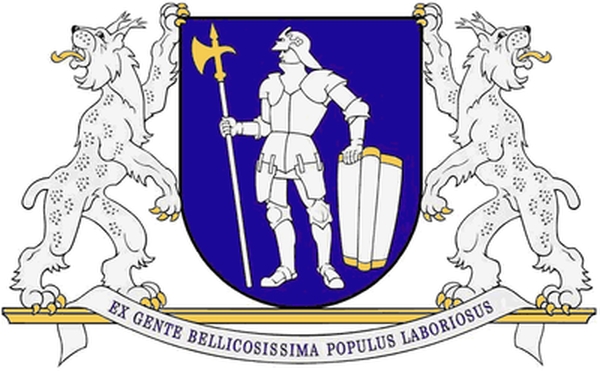
Dzukija is the region of Lithuania with the highest number of forests. For most of its inhabitants forest was and still is a source of livelihood. Not only do the dried and canned mushrooms gathered by the Dzuks end up on Lithuanian tables, but also they are are exported to Western European countries. Mushroom and berry picking have become something akin to an old tradition. In autumn, there are always many many Dzuks selling “gifts of the forest” by the roads. There is even a Dzuk saying: „Jei ne grybai ir ne uogos, dzūkų mergos būtų nuogos” (If it wasn’t for berries and fungus, all dzuk girls would all be nudes).
The Dzuks make many of their items with their own hands – usually things for everyday use, beautiful ornaments, furniture, houses.
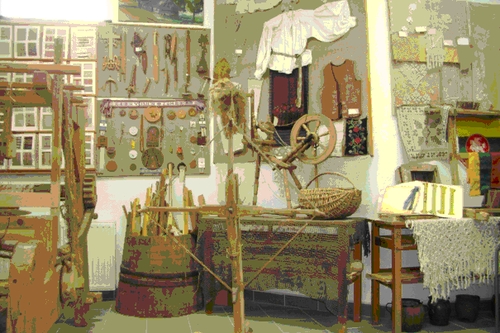
Exposition of items in the Ethnographical Museum in Puńsk. Photography by Piotr Grablunas.
Dzukija’s national costums also differ from those used in other regions of Lithuania . A different attire was expected in a church, on a wedding or when simply visiting someone. Female costumes consist of: a shirt, a skirt, an apron, a belt, a vest, headgear (galloon, crown, coif, kerchief) and footgear. Dzuk women often weave belts and are especially gifted when it comes to different patterns: rakes, trees, roses, birch leaves, stars, bears, goats. Married women and maidens wear various headgear. Girls wear golden galoons and crowns, married women – white or colourful coifs made of silk, wool, cotton with a white or colourful coifs. Female costumes seem more varied than men’s: they are more colourful and appear to be richer.
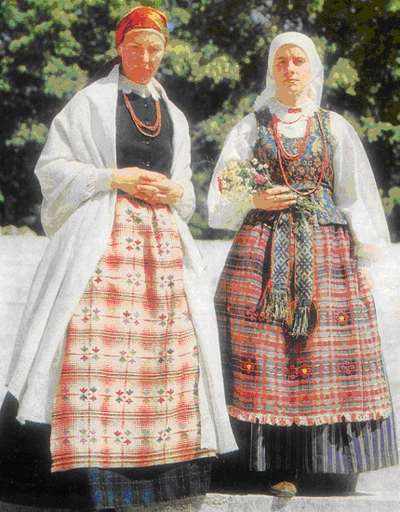
Examples of female costumes. J. Balčikonis. Lietuvių liaudies menas. Drabužiai. 1974
Male costumes are also colourful but more modest: a hat or a cap on the head, a linen shirt with red ornaments, an ornamental belt and checked trousers. Nowadays Lithuanians wear national costumes while celebrating various festivities.
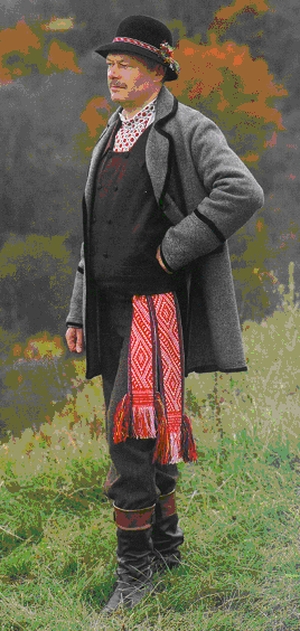
Male national costume. T. Jurkuvienė. Lietuvių tautinis kostiumas. 2006.
One of the symbols of ethnic identity, connecting traditional and modern culture, is a string instrument called kanklės in Lithuanian, kokle in Latvian and gęśle in Polish, which is known not only in Lithuania, but also in Latvia, Estonia, Finland and Belarus (Tarnaiskaitė 2009: 41
 Tarnaiskaitė 2009 / komentarz/comment/r /
Tarnaiskaitė 2009 / komentarz/comment/r / Tarnauskaitė [-Palubinskienė], Vida 2009. Kanklės lietuvių etninėje kultūroje. Wilno: Vilniaus pedagoginio universiteto leidykla.
 ).
).
Simple little kanklės. http://upload.wikimedia.org/wikipedia/commons/2/24/Kankles.jpg
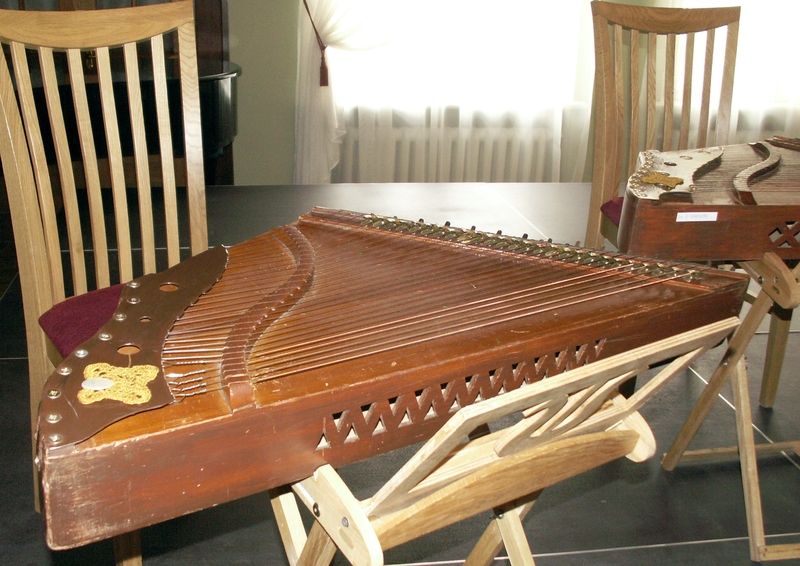
Kanklės with a music stand. . http://upload.wikimedia.org/wikipedia/commons/9/90/Kankl%C4%97s_su_piupitru.JPG
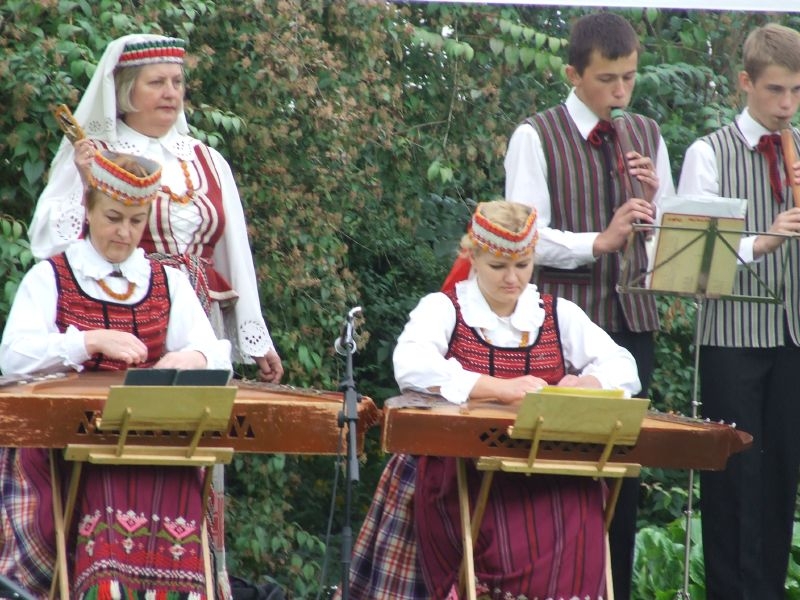
Folk music band playing on kankles. http://upload.wikimedia.org/wikipedia/commons/0/09/Lithuanian_musicians_Rasa.jpg

Exemplary folk songs in the dialect of the Dzuks from Poland. Krištopaitė, Nuo Punsko iki Seinų, 1997

Krištopaitė, Nuo Punsko iki Seinų, 1997
One of the famous Lithuanians from Dzukija (from the area of Druskinnikai) were Mikalojus Konstantinas Čiurlionis, a painter and composer; and Vincas Krėvė-Mickevičius – a Lithuanian classical writer born not far from Alytus.
ISO Code
ISO 639-1 lt
ISO 639-2 lit
ISO 639-3 lit
The Linguasphere 54-AAA-a
ISO 639-2 lit
ISO 639-3 lit
The Linguasphere 54-AAA-a
- przyp01
- przyp02
- przyp03
- przyp04
- przyp05
- przyp06
- przyp07
- przyp08
- przyp09
- przyp10
- przyp11
- przyp12
- przyp13
- przyp14
- przyp15
- przyp16
- przyp17
- przyp18
- przyp19
- przyp20
- przyp21
- przyp22
- przyp23
- przyp24
- przyp25
- przyp26
- przyp27
- przyp28
- przyp29
- przyp30
- przyp31
- przyp32
- przyp33
- przyp34
- przyp35
- przyp36
- przyp37
- przyp38
- przyp39
- przyp40
- przyp41
- przyp42
- przyp43
- przyp44
- przyp45
- przyp46
- przyp47
- przyp48
- przyp49
- przyp50
- Hasiuk 1978
- Marcinkiewicz 2003
- Jackiewicz 2003
- Vaičiulytė-Romančuk 2006
- Niewulis 2005
- Zinkevičius 1978
- Tarnaiskaitė 2009
- Butkus 2011
- Jovaišas 1999
- Zinkevičius 1996
- Makowski 1986
- zagrożenie języków / language endangerment
- Godło Dzukiji
- Proste małe kanklės
- Kanklės z pulpitem
- Ludowy zespół muzyczny grający na gęślach
- Najstarszy litewski manuskrypt (pacierz) napisany
- Pierwsza strona Katechizmu Mażwida
- Ludy bałtyckie na przełomie XII i XIII w.
- Zasięg języka litewskiego w XVI wieku
- Litwa w latach 1867-1914, podział na gubernie
- Język litewski w II Rzeczypospolitej
- Gwary litewskie
- Etnograficzne regiony Litwy
- Dwujęzyczna tablica powitalna
- Gwary litewskie wg Zdancewicza
- Zbiór przedmiotów muzeum etnograficznego w Puńsku
- Przykłady strojów kobiecych
- Męski strój ludowy
- Piosenka ludowa w gwarze Dzuków 1
- Piosenka ludowa w gwarze Dzuków 2
- Akcentuacja wyrazów
- Tablica liceum w Puńsku
- Tablica szkoły podstawowej w Przystawańcach
- Podręczniki do szkoły podstawowej po litewski
- Tablica Domu Kultury w Puńsku
- Okładka dwutygodnika Aušra
- Okładka miesięcznika Aušrelė
- Publikacje o Litwinach w Polsce
- Publikacja o folklorze mniejszości litewskiej
- podręcznik do historii Litwy i regionu
- Podręcznik w języku litewskim